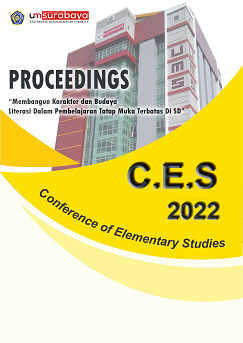PENTINGNYA INTERAKSI GURU DAN SISWA DALAM PEMBELAJARAN JARAK JAUH
Abstrak
This study aims to describe how important the interaction of teachers and students in distance learning is. The research method used is qualitative research, with data collection techniques in the form of observation and interviews. The focus of this research is to examine recent research on the importance of interaction in learning compared to other things and to briefly describe the types of interactions that have been used in distance education, explain the importance of designing interactions into distance learning environments, and design steps for learning steps that can facilitate interaction effectively. The results of this study indicate that the quality of interaction in distance learning still needs to be improved by focusing on teacher and student interactions.
Â
Keywords: Distance education; Type of interaction, Teacher and student interaction; Interaction design
Referensi
Abuya, B. A., Admassu, K., Ngware, M., Onsomu, E. O., & Oketch, M. (2015). Free primary education and implementation in Kenya: The role of primary school teachers in addressing the policy gap. SAGE Open, 5(1). https://doi.org/10.1177/2158244015571488
Ackers, J., & Hardman, F. (2001). Classroom interaction in kenyan primary schools. Compare, 31(2), 245–261. https://doi.org/10.1080/03057920120053238
Agus Purwanto, Rudy Pramono, Masduki Asbari, Priyono Budi Santoso, Laksmi Mayesti Wijayanti, Choi Chi Hyun, R. S. P. (2020). Studi Eksploratif Dampak Pandemi COVID-19 Terhadap Proses Pembelajaran Online di Sekolah Dasar. EduPsyCouns, 2, 1–12.
Alifah, U. (2021). panduan pengajuan prosposal jarak jauh. 3(2), 6.
Asmuni. (2020). Problematika Pembelajaran Daring di Masa Pandemi Covid-19 dan Solusi Pemecahannya. Jurnal Paedagogy: Jurnal Penelitian Dan Pengembangan Pendidikan, 7(4), 281–288.
Asrilia Kurniasari1, Fitroh Setyo Putro Pribowo2, D. A. P., & Pendidikan. (2020). Analisi Efektifitas Pelaksanaan Belajar Di rumah (BDR) Selama Pandemi Covid-19. 6(3).
Baddeley, J. L., & Singer, J. A. (2009). A Social Interactional Model of Bereavement Narrative Disclosure. Review of General Psychology, 13(3), 202–218. https://doi.org/10.1037/a0015655
Cao, Q., Griffin, T. E., & Bai, X. (2001). The importance of synchronous interaction for student satisfaction with course web sites. Journal of Information Systems Education, 20(3), 331–339.
Chusna, A., Zahra, A., Dermawan, K. I., Anggini, C. T., & Eva, N. (2021). Problematika Orang Tua dalam Mendampingi Pembelajaran Daring Anak Selama Pandemi Covid-19 dan Solusi Pemecahannya. 83–97.
Gabdulchakov, V. F., & Kazan. (2014). Communicative ɋore of Interaction and its Influence on Educational Result. Procedia Sociial And Behavior Sciences, 146, 381–384.
Hamidah, J. S., Sarina, M. N., & Jusoff, K. (2009). The Social Interaction Learning Styles of Science and Social Science Students. Asian Social Science, 5(7), 58–64. https://doi.org/10.5539/ass.v5n7p58
Handayani, L. (2020). Keuntungan , Kendala dan Solusi Pembelajaran Online Selama Pandemi Covid-19 : Studi Ekploratif di SMPN 3 Bae Kudus Lina Handayani. 1(2), 15–23.
Hsieh Chang, S. H., & Smith, R. A. (2008). Effectiveness of personal interaction in a learner-centered paradigm distance education class based on student satisfaction. Journal of Research on Technology in Education, 40(4), 407–426. https://doi.org/10.1080/15391523.2008.10782514
Kartika, H. (2020). Pola Information Flows pada Evaluasi Pembelajaran Daring di Masa Pandemi Covid-19. Pustabiblia: Journal of Library and Information Science, 4(2), 209–224. https://doi.org/10.18326/pustabiblia.v4i2.209-224
Keengwe, J., & Bhargava, M. (2013). Mobile learning and integration of mobile technologies in education. https://doi.org/10.1007/s10639-013-9250-3
Murray, M., Pérez, J., Geist, D., & Hedrick, A. (2012). Student interaction with online course content: Build it and they might come. Journal of Information Technology Education:Research, 11(1), 125–140. https://doi.org/10.28945/1592
Mushfi, M., Iq, E., & Interaction, S. (2017). MODEL INTERAKSI SOSIAL DALAM MENGELABORASI KETERAMPILAN SOSIAL. 04(02), 211–227.
Nasution, M. K. M., & Nasution, M. K. M. (2013). Konsep Penelitian dalam Teknologi Informasi Konsep Penelitian dalam Teknologi Informasi. 13(1).
Oktavian, R., Aldya, R. F., Indonesia, U. K., & Tunggadewi, U. T. (2020). Efektifitas Pembelajaran Daring Terintegrasi Di Era 4.0. 20(2), 129–135.
Ollendick, T. H., & Benoit, K. E. (2012). A Parent-Child Interactional Model of Social Anxiety Disorder in Youth. Clinical Child and Family Psychology Review, 15(1), 81–91. https://doi.org/10.1007/s10567-011-0108-1
Picciano, A. G. (2019). Developing an Asynchronous Course Model at a Large, Urban University. Online Learning, 2(1), 1–14. https://doi.org/10.24059/olj.v2i1.1926
Robertson, S. L. (2012). Signposts in ‘ doing ’ critical transnational educational policy analysis. 10–12.
Salamah, E. R. (2018). Pengaruh Kultur Sosial Sosial terhadap Sistem Pendidikan. Proceedings of the ICECRS, 1(3), 155–164. https://doi.org/10.21070/picecrs.v1i3.1375
Salamah, E. R. (2021). Educational Interaction Of Elementary Schooll V Class. Procceding the Anunual Conference International Conference On Isalamic Education, 117–122.
Salamah, E. R., & Rifayanti, Z. E. T. (2022). Dampak Pembelajaran Online Pada Motivasi Belajar Siswa Sekolah Dasar. Jurnal Simki Pedagogia, 5(1), 34–44. https://doi.org/10.29407/jsp.v5i1.99
Sato, M. (2017). Interaction Mindsets, Interactional Behaviors, and L2 Development: An Affective-Social-Cognitive Model. Language Learning, 67(2), 249–283. https://doi.org/10.1111/lang.12214
Spinelli, M., Lionetti, F., & Setti, A. (2020). Parenting Stress During the COVID-19 Outbreak : October. https://doi.org/10.1111/famp.12601
Suganda1, R., Sutisnawati2, A., & Lyesmaya3, D. (2019). Meningkatkan Keterampilan Interaksi Sosial Pada Siswa Sekolah Dasar Melalui Metode Pembelajaran Debat. Jurnal Perseda, 2(2), 97–104.
Swan, K. (2001). Virtual interaction : Design factors affecting student satisfaction and perce ... Education, 22(2), 306–331. http://www.rcet.org/research/publications/interactivity.pdf
Thurmond, V., & Wambach, K. (2004). Understanding interactions in distance education: A review of the literature. International Journal of Instructional Technology and Distance Learning, 1(1).
Wanstreet, C. E. (2006). Interaction in Online Learning Environments: A Review of the Literature. Quarterly Review of Distance Education, 7(4), 399–411.
Wijayanti, R. M., Fauziah, P. Y., Anak, P., Dini, U., Yogyakarta, U. N., Sekolah, P. L., & Yogyakarta, U. N. (2021). Perspektif dan Peran Orangtua dalam Program PJJ Masa Pandemi Covid-19 di PAUD. 5(2), 1304–1312. https://doi.org/10.31004/obsesi.v5i2.768
Wiley, D., & Hilton III, J. L. (2018). International Review of Research in Open and Distributed Learning. International Review of Research in Open and Distributed Learning, 32(3), 83–93.






